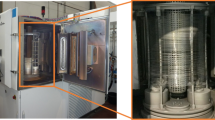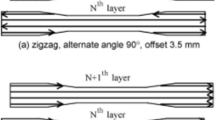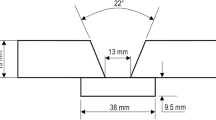Abstract
The development of high-strength and ultrahigh-strength fine-grain steels is especially enhanced due to requirements in the range of mobile crane construction, bridge construction, and general steel construction purposing a consistent utilization of lightweight construction and an increase of payloads. However, currently available filler metals limit the use of novel fine-grained structural steels in modern welded constructions, since the strength of the steels in the weld metal can neither be achieved nor exceeded Heuser and Jochum (Mater Werkst 38(7):515–520, 2007). The coating of GMA welding wire electrodes by means of PVD coating processes enables the application of thin, functional layers influencing the welding process and the weld metal. The mechanical and technological properties of the weld metal can thus be influenced to an extent that cannot be achieved even with state-of-the-art welding consumables. The influence of niobium, zirconium, and nickel layers is shown in the described investigations. In particular, the fine-grain and carbide-forming effect of niobium and zirconium and the associated influence on the mechanical and technological characteristics are illustrated. In addition, the effect of a nickel-coated welding wire electrode on the weld metal is explained. The toughness properties are at the focus of the investigations. The aim is to increase the strength while retaining the toughness properties as far as possible.





















Similar content being viewed by others
References
Ummenhofer T, Spannaus M, Steidl G, Hölbling W u, Di Rosa V (2013) Die Anwendung hochfester Feinkornbaustähle im konstruktiven Ingenieurbau. Stahlbau 82(4):236–245
DVS – DEUTSCHER VERBAND FÜR SCHWEISSEN UND VERWANDTE VERFAHREN E.V (2012) Metall-Schutzgasschweißen von Feinkornbaustählen. Merkblatt DVS 0916
Heuser H u, Jochum C (2007) Schweißzusatzwerkstoffe können/müssen nicht immer die Anforderungen der Grundwerkstoffe erfüllen. Mater Werkst 38(7):515–520
Wesling V, Schram A, Müller T u, Treutler K (2016) Influencing the arc and the mechanical properties of the weld metal in GMA-welding processes by additive elements on the wire electrode surface. IOP Conf Ser Mater Sci Eng 118:012006
Schaupp T, Kannengießer T, Burger S, Zinke M u, Jüttner S (2018) Einfluss der Wärmeführung auf die Wasserstoffkonzentration in geschweißten höherfesten Feinkornbaustählenbeim Einsatz modifizierter Sprühlichtbogenprozesse. Schweißen und Schneiden 5:290–297
Treutler K, Schram Au. Wesling V (2017) 36. Assistentenseminar Fügetechnik. Beeinflussung des MSG-Schweißprozesses und der Eigenschaften des Schweißgutes durch Zusatzelemente auf der Drahtoberfläche. DVS-Berichte, Band 320. Düsseldorf: DVS Media GmbH
Pitrun M, Nolan D u, Dunne D (2004) Diffusible hydrogen content in rutile flux-cored arc welds as a function of the welding parameters. Weld World 48(1-2):2–13
Clausthaler Zentrum für Materialtechnik, Shaker Verlag GmbH u (2017) Niedersächsisches Symposium Materialtechnik: Tagungsband 2. Niedersächsisches Symposium Materialtechnik. Nutzung von Al-beschichteten Drahtelektroden beim MSG-Schweißen zur Minderung des Legierungsabbrandes. 23. bis 24. Februar 2017. Fortschrittsberichte der Materialforschung und Werkstofftechnik Band 4. Herzogenrath: Shaker
DIN Deutsches Institut für Normung e. V (2011) Warmgewalzte Erzeugnisse aus Baustählen. Teil 6: Technische Lieferbedingungen für Flacherzeugnisse aus Stählen mit höherer Streckgrenze im vergüteten Zustand. DIN EN 10025-6. Berlin: Beuth Verlag GmbH
DIN Deutsches Institut für Normung e. V (2012) Schweißzusätze - Prüfverfahren. Teil 1: Prüfverfahren für Prüfstücke zu Entnahme von Schweißgutproben an Stahl, Nickel und nickellegierungen. DIN EN ISO 15792-1. Berlin: Beuth Verlag GmbH
Dilthey U (2005) Schweißtechnische Fertigungsverfahren 2. Verhalten der Werkstoffe beim Schweißen. VDI-Buch. Springer-Verlag Berlin Heidelberg, Berlin, Heidelberg
Lampke T, Wagner Gu. Wagner MF-X (eds) (2018) Tagungsband zum 20. Werkstofftechnischen Kolloquium. 14. und 15. März 2018 in Chemnitz. Influence on the weld strength of high-strength fine-grained structural steels by thin-film-coated GMA welding electrodes. Schriftenreihe Werkstoffe und werkstofftechnische Anwendungen, Band 72., S. 138–147 Chemnitz: Eigenverlag Chemnitz
DIN Deutsches Institut für Normung e. V (2017) Metallische Werkstoffe - Kerbschlagbiegeversuch nach Charpy. Teil 1: Prüfverfahren. DIN EN ISO 148-1. Berlin: Beuth Verlag GmbH
DIN Deutsches Institut für Normung e. V (2006) Metallische Werkstoffe - Härteprüfung nach Vickers. Teil 1: Prüfverfahren. DIN EN ISO 6507-1. Berlin: Beuth Verlag GmbH
Acknowledgments
We thank the Hermann Fliess GmbH & Co KG and the SSAB Swedish Steel GmbH for the support of the investigations.
Funding
The investigations presented were supported within the framework of the Central Innovation Program for SMEs (ZIM) by the Federal Ministry for Economic Affairs and Energy on the basis of a resolution of the German Bundestag (grant number: ZF4419001 FH7).
Author information
Authors and Affiliations
Corresponding author
Additional information
Publisher’s note
Springer Nature remains neutral with regard to jurisdictional claims in published maps and institutional affiliations.
Recommended for publication by Commission IX - Behaviour of Metals Subjected to Welding
Rights and permissions
About this article
Cite this article
Gehling, T., Treutler, K. & Wesling, V. Targeted influence on the weld strength of high-strength fine-grain structural steels in the GMA welding process through functionalized weld material surfaces. Weld World 63, 783–792 (2019). https://doi.org/10.1007/s40194-019-00707-2
Received:
Accepted:
Published:
Issue Date:
DOI: https://doi.org/10.1007/s40194-019-00707-2




